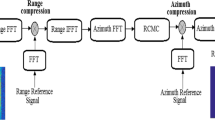Abstract
Compressive sensing (CS) techniques offer a framework for the detection and allocation of sparse signal with a reduced number of measurements. This paper proposes a novel SAR range compression, namely compressive sensing with chirp scaling (CS-CS), achieving the same range resolution as conventional SAR approach, while using fewer range samplings. In order to realize accurate range cell migration correction (RCMC), chirp scaling principle is used to construct reference matrix for compressive sensing recovery. Additionally, error diagrams are designed for measurement of the performance of CS-CS, and some experiments of using real data are performed to deal with the errors caused by three conditions: SNR, sparsity and sampling.
Similar content being viewed by others
References
Donoho D. Compressive sensing. IEEE Trans Inf Theory, 2006, 52: 1289–1306
Ender J H G. On compressive sensing applied to radar. Signal Process, 2010, 90: 1402–1414
Herman M, Strohmer T. Compressed sensing radar. In: IEEE International Conference on Acoustics, Speech and Signal Processing (ICASSP), Dallas, 2008. 1509–1512
Herman M, Strohmer T. High-resolution radar via compressed sensing. IEEE Trans Signal Process, 2009, 57: 2275–2284
Baraniuk R, Steeghs P. Compressive Radar Imaging. In: IEEE Radar Conference, Edinburgh, 2007. 128–133
Varshney K R, Cetin M, Fisher JW, et al. Sparse representation in structured dictionaries with application to synthetic aperture radar. IEEE Trans Signal Process, 2008, 56: 3548–3561
Zhang Y X, Sun J P, Tian J H, et al. Compressive sensing SAR imaging with real data. In: 3rd International Congress on Image and Signal Processing (CISP), Yantai, 2010. 2026–2029
Alonso M T, Lopez-Dekker P, Mallorqui J J. A novel strategy for radar imaging based on compressive sensing. IEEE Trans Geosci Remote Sens, 2010, 48: 4285–4295
Bhattacharya S, Blumensath T, Mulgrew B, et al. Fast encoding of synthetic aperture radar raw data using compressed sensing. In: IEEE/SP 14th Workshop on Statistical Signal Processing (SSP’07), Madison, 2007. 448–452
Ertin E. Frequency diverse waveforms for compressive radar sensing. In: International Waveform Diversity and Design Conference (WDD), Niagara Falls, 2010. 216–219
Shastry M C, Narayanan R M, Rangaswamy M. Compressive radar imaging using white stochastic waveforms. In: International Waveform Diversity and Design Conference (WDD), Niagara Falls, 2010. 90–94
Candes E J, Romberg J. Sparsity and incoherence in compressive sampling. Inverse Probl, 2007: 23: 969–985
Candes E, Wakin M. An introduction to compressive sampling [a sensing/sampling paradigm that goes against the common knowledge in data acquisition]. IEEE Signal Process Mag, 2008, 25: 21–30
Chen S, Donoho D, Saunders M. Atomic decomposition by basis persuit. SIAM J Sci Comput, 1998, 20: 33–61
Cumming I G, Wang F H. Digital Processing of Synthetic Aperture Radar Data: Algorithms and Implementation. Boston/London: Artech House, Inc 2005
Baraniuk R G, Cevher V, Duarte M F, et al. Model-based compressive sensing. IEEE Trans Inf Theory, 2010, 56: 1982–2001
Xiao P, Li C S, Yu Z. Effects of noise, sampling rate and signal sparsity for compressed sensing synthetic aperture radar pulse compression. In: 2011 IEEE International Geoscience & Remote Sensing Symposium (IGARSS 2011), Vancouver, 2011. 656–659
Author information
Authors and Affiliations
Corresponding author
Rights and permissions
About this article
Cite this article
Xiao, P., Yu, Z. & Li, C. Compressive sensing SAR range compression with chirp scaling principle. Sci. China Inf. Sci. 55, 2292–2300 (2012). https://doi.org/10.1007/s11432-012-4613-8
Received:
Accepted:
Published:
Issue Date:
DOI: https://doi.org/10.1007/s11432-012-4613-8




